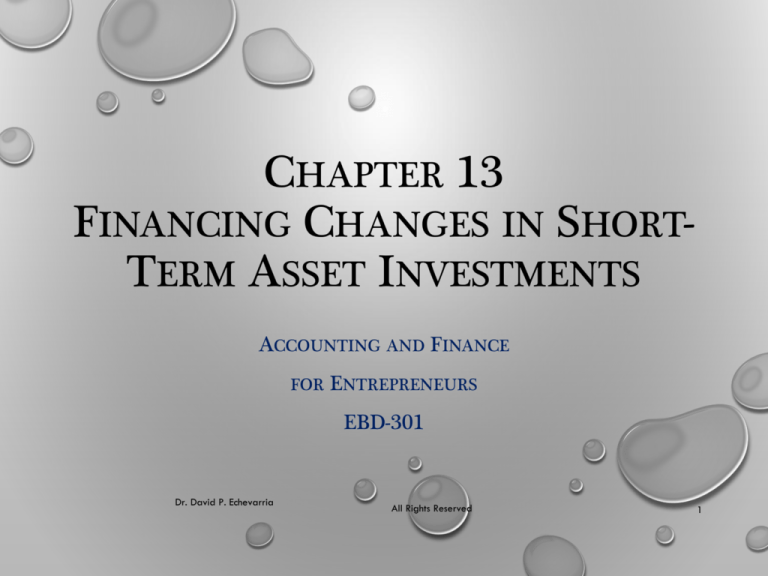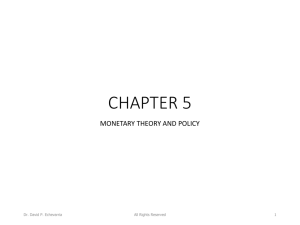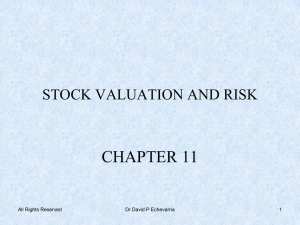
CHAPTER 13
FINANCING CHANGES IN SHORTTERM ASSET INVESTMENTS
ACCOUNTING AND FINANCE
FOR
ENTREPRENEURS
EBD-301
Dr. David P. Echevarria
All Rights Reserved
1
WHY DO BUSINESSES BORROW MONEY?
• Most frequent reason why businesses borrow is to finance growth
• Finance additional working capital
• Cash
• Increase Receivables
• Acquire more inventory
• Finance additional fixed assets
• Equipment
• Real Estate: land, buildings, rolling stock
Dr. David P. Echevarria
All Rights Reserved
Slide 2
SOURCES OF SHORT-TERM FINANCING
• Spontaneous
• Trade Credit – Accounts Payable (inventory)
• Accrued Wages & Salaries Payable
• Planned
• Borrowing
• Short-term loans
• Line of credit
• Raising External Capital
• Selling equity
• Selling debt
Dr. David P. Echevarria
All Rights Reserved
Slide 3
FACTORS AFFECTING SHORT-TERM
FINANCING STRATEGY
• Current Cash Position of Business
• Desired levels of Working Capital
• Restrictive Loan covenants (existing debt)
• Economic Conditions
• Nature of Cash Inflows and Outflows
• Seasonal effects
• Efficiency of credit collection
Dr. David P. Echevarria
All Rights Reserved
Slide 4
WORKING CAPITAL MANAGEMENT
REVISITED
• Short-Term Assets
• Cash
• Accounts Receivable
• Inventory
• Prepaid Expenses
• Short-Term Liabilities
• Accounts Payable (terms for trade credit)
• Accrued Expenses (wages, taxes, etc.)
• Notes Payable (S-T bank loans)
• Efficiency of Cash Conversion Cycle
Dr. David P. Echevarria
All Rights Reserved
Slide 5
OWNER’S WORKING CAPITAL
RISK PREFERENCES
• Working Capital Management Strategy
• Aggressive
• Current and quick ratios close to 1 and < 1, respectively
• Minimal cash on hand
• Middle of the road
• Current and quick ratios close to 2.0 and 1.0, respectively
• Able to pay maturing obligations
• Conservative
• Current and quick ratios close to >>2 and >>1, respectively
• Highly liquid
Dr. David P. Echevarria
All Rights Reserved
Slide 6
SALES GROWTH AND PRODUCT
LIFE CYCLES
• Mature product cycles require resources to develop and replace
aging product lines
• Periods of rapid sales growth will require more cash to finance
receivables and invest in more inventory
• Availability of bank loans and favorable trade credit terms a must
• High percentage of net income must be reinvested in business
Dr. David P. Echevarria
All Rights Reserved
Slide 7
IMPACT OF LIQUIDITY CONSTRAINTS
• Ability to increase bank borrowing may be restricted by prior loan
covenants
• Required to maintain minimum liquidity ratios
• Need to carefully plan use of trade credit and accrued expenses
• [See Equation (11.1)] : Tying magnitude of change in inventory to
change in Trade Credit (A/P)
• Importance of sensitivity analysis (Figure 11.1)
• Importance of Cash Sales
Dr. David P. Echevarria
All Rights Reserved
Slide 8
FORMS OF COMMERCIAL TRADE CREDIT
• Open Accounts
• Vendor gives its customers the ability to order on credit so long as
the accounts are up to date
• Consignment
• Vendor retains title to the goods it “sells” to the buyer
• Floor Plan Financing
• Manufacturer finances dealer’s inventory
Dr. David P. Echevarria
All Rights Reserved
Slide 9
SHORT-TERM BANK BORROWING
• Uncollateralized Loans
• Funds lent on basis of good credit history of borrower
• Typically of short duration: less than 3 years
• Collateralized Loans
• By receivables (assignment or pledging)
• By goods (inventory)
• Other assets with a cash value (insurance policy)
• Loan Type
• Regular: principal and accrued interest due at maturity
• Installment: monthly payments of Principal & Interest
Dr. David P. Echevarria
All Rights Reserved
Slide 10
SHORT-TERM BANK BORROWING
• Cost of Add-on Interest Loan
• Rate = Interest $ / Loan Amount
• Cost of Discount Loan
• Rate = Interest $ / (Loan Amount – Interest $)
• Installment Loan: (Approx. Annual Percentage Rate)
• AAPR = (2 x n x Interest Rate) / (m + 1)
• Where: n = number of annual payments and m = total payments.
• Line of Credit: interest charges same as credit card
Dr. David P. Echevarria
All Rights Reserved
Slide 11
FINANCING INTERNATIONAL TRADE
• BANKERS’ ACCEPTANCES
• Bankers’ Acceptances represent a term loan to an importer.
• The bank may retain the loan on its books or sell the acceptance in
the secondary market
• FORFAITING
• Essentially the purchase of foreign receivables by a third party
• Non-recourse is typical
• Goods sold are not used as collateral for a loan to pay the seller
• Financing can be up to 5 years
Dr. David P. Echevarria
All Rights Reserved
Slide 12
HOMEWORK QUESTIONS
•
1. The business has three sources for financing increases in short term assets.
• What are they and how do they impact the current ratio? The quick ratio?
•
2. How does the focus of working capital management differ from the notion of net working
capital management?
•
3. If you where constructing a model of the business’s cash flows, how would you specify the
relationship between inventory and accounts payable in terms of cause and effect?
•
4. How does the description of payables and accruals as spontaneous sources differ from their
description as planned outflows?
• 5. There are three major working capital management strategies; conservative, moderate, and
aggressive. How do they differ in terms of liquidity ratios? Cash ratios? In what marketdemand environments are they most likely to be used in successfully?
Dr. David P. Echevarria
All Rights Reserved
Slide 13
HOMEWORK QUESTIONS
• 6. Why do some high-growth businesses seem to experience liquidity problems?
•
7. How might businesses anticipating high growth episodes prepare themselves
from a working capital point of view? Where in the product’s life cycle are
businesses most likely to experience high growth rates?
•
8. If you were asked to develop the organizational outline of a cash management
system with built in checks and balances, what kinds of requirements would you
specify?
•
9. What benefits can be derived from good vendor relationships?
•
10. What are the benefits of an open account? Floor plan financing?
Consignment?
Dr. David P. Echevarria
All Rights Reserved
Slide 14



